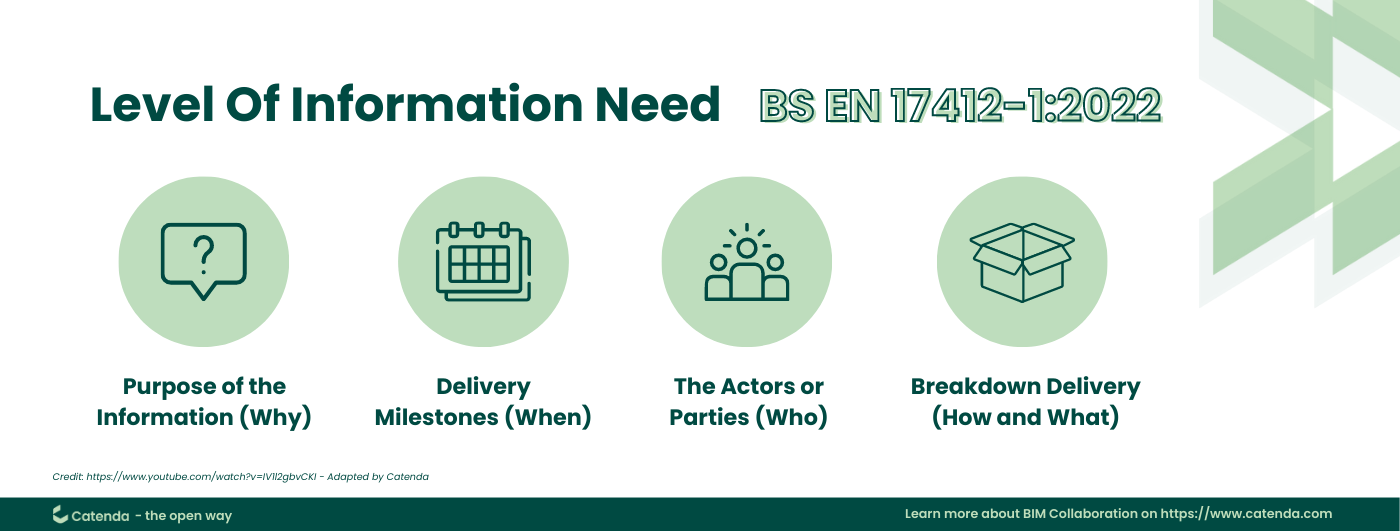Data and information are vital ingredients in the success of any BIM (Building Information Modeling) projects. According to BS EN ISO 19650:2018, the new terminology “Level of information need” (LOIN) was introduced with the aim of setting standards and requirements for the use and exchange of information.
What is the definition of the level of information need (LOIN) in ISO 19650 standard?
BS EN ISO 19650:2018 defines the level of information need (LOIN) as the quality, quantity and granularity of information. Additionally, each BIM project information deliverable needs to be determined based on its purpose(s).
What information is included in the Level of Information Need?
The Level of Information Need (LOIN) includes a range of critical details that are required for a BIM project. Depending on different projects and design phases, information can be varied from geometric information, alphanumeric information to documentation. This encompasses the level of detail, dimensionality, location, appearance, parametric behavior, accuracy, and reliability of model elements.
Information is further categorized based on the specifics of a project or asset, and their respective lifecycle stages. This can include:
- Design and construction data
- Operation and maintenance information
- Sustainability and energy performance
- Regulatory and statutory compliance
LOIN also defines the when and how of data delivery, ensuring the correct information is delivered to the right people, at the right time, and in the right format. This is crucial to ensure the efficient and effective execution of BIM projects.
Why is the level of information need (LOIN) framework important for BIM projects management?
In BIM projects, to ensure precision and efficiency, information should be delivered on time, with the proper content and amount, and to the right people. Therefore, it is crucial to have a framework to generally determine the richness of information, which is supposed to minimize the occurrence of either insufficient, wasteful or incorrect project information.
The Level of Information Need (LOIN) is pivotal to BIM projects because it offers a structured method to manage data and ensure that necessary information is accessible to the appropriate individuals at the right time. LOIN helps to establish the specific information requirements at various stages of a construction project.
Managing the level of information accurately can contribute significantly to the success of a project. It allows for a more refined decision-making process, ensuring that only the necessary data is considered at each stage. This can lead to improved efficiency, reduced errors, and better project outcomes.
LOIN can also assist in aligning the project’s information requirements with the standards set by BS EN ISO 19650:2018. This alignment ensures that the project adheres to the best practices in the industry, which can enhance the project’s overall quality and delivery.
Furthermore, understanding the LOIN can aid in the development of a comprehensive BIM Execution Plan. This plan outlines what information is needed and ensures that those requirements align with the project’s objectives, thus driving project success.
Lastly, LOIN is instrumental in determining the Level of Development (LOD). This concept, complementary to LOIN, recognizes that each project has unique requirements and information needs.
A Practical 4-Step to apply LOIN in Construction Projects

Here’s a breakdown of the key steps to implement Level of Information Need (LOIN) effectively:
- Identify the purpose of the information: It is crucial to specify needed information in correlation with the purpose to carry a task or make a decision at a very first step.
- Setting delivery milestones: The project team also has to consider and anticipate the level of information and actual use of it at specific stages over different milestones throughout the life of a project.
- Specifying the actors or parties involved: Throughout the project life, there are not only actors but also various parties participating. Therefore, it should be precise who will be in charge of producing information and who will receive and process it.
- Determining the kind of information and the method to be delivered: There are several kinds of information to be considered over multiple stages and milestones of construction projects.
- Geometrical information: detail, dimensionality, location, appearance and parametric behavior
- Alphanumeric information: identification and information content
- Documentation: reports, specifications, manuals, photographs, sketches, signed documents, physical information and handovers.
The guidance of BS EN ISO 19650:2018 also emphasises the integration between both people and technology. Following that, the level of information need should be intelligible for people and technology to verify and validate. In the construction industry, with the support of automation and technology intelligence, human errors can be minimized to better and faster reach the standard.
At the moment, the level of information need is viewed at the guidance level but not the executive. Different countries and regions have different approaches to specify the level of information need. However, when defining project information strategy and breakdown structure, it is essential to clarify information requirements and the level of information need. By capturing high quality information and delivering it in an accurate quantity to the right people at a proper stage helps enhance clash detection and save a lot of time and effort processing. And as a result the overall performance and efficiency of the project can be improved considerably.